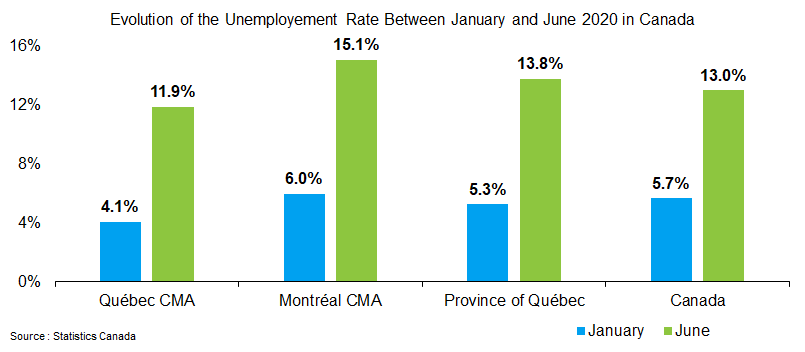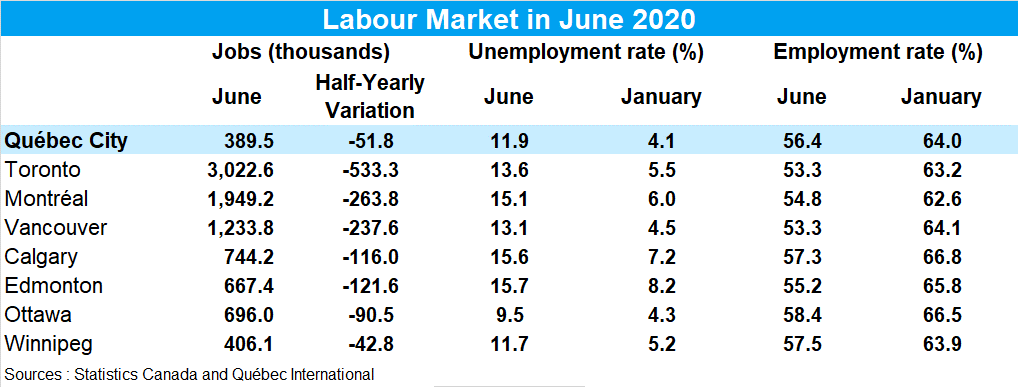Cautionary Note
The available data for the Québec City census metropolitan area (CMA) was given special treatment (three-month moving average) due to the small sample size, which mitigated the strong fluctuations in the data. The current situation causes extreme variations which cannot be fully observed with this data. Furthermore, this data provides insight into the trend in the past three months. Thus, the data collected in April and May influenced the estimations published for the month of June. Please note that we use comparable data for the province of Quebec and the other CMAs in this document.
The Labour Force Survey’s (LFS) data for June was collected from respondents during the reference week of June 14 to 20. For reference, the data for April was collected from respondents during the week of April 12 to 18, at which time the lifting of lockdown was just starting. The data for May was collected from May 10 to 16, as reopenings were going strong. Since then, the lifting of economic restrictions has continued. For instance, on May 25, the manufacturing sector was authorized to resume all of its activities. Other sectors and services also reopened, like museums, libraries, professional health care services, therapeutic, personal and beauty services as well as shopping centres. Note that for some sectors, reopening was delayed in the Montréal metropolitan area. Finally, the June data does not reflect the most recent stage of restriction lifting announced on June 25.
Statistics Canada’s definition of “unemployment” is based on the activity of job search and the availability to take a job. Therefore, the definition of unemployed people are those who, during the reference week of June 14 to 20, were available to work and:
- were without work, but had looked for work in the past four weeks,
- were on temporary layoff with an expectation of recall, or
- were without work, but had a job to start within four weeks from the reference week.
To learn more, please visit: https://www150.statcan.gc.ca/n1/en/catalogue/71-543-G
Highlights
- According to Statistics Canada, there were an estimated 389,500 people employed in the region in June, 5,900 more (+1.5%) than the previous month. The unemployment rate remained stable at 11.9% for the second month in a row.
- From January to June, the number of people employed in the region dropped by 51,800 (-11.7%). This is the most significant contraction ever recorded in the Québec City census metropolitan area (CMA) for that period.
- Due to COVID-19, the number of unemployed people shot up by 33,700 people (+176.4%) in the first half year (January–June). This population has almost tripled.
- According to the LFS, the unemployment rate reached 11.9% in the Québec City CMA in June, an increase of 7.8 percentage points compared to January.
- The labour force registered a drop of 18,100 people compared to January, reaching 442,300 people in June.
- In Québec City, comparable data collected since January shows a decrease of 544,400 in the number of people employed (-12.5%). As for the unemployment rate, it went from 5.3% at the beginning of the year to 13.8% in June.


Commentary
The economic hiatus caused by COVID-19 is an unprecedented event in recent history. This pause, based on public health recommendations, has sent shockwaves through the labour market. However, the data available for the Canadian census metropolitan areas (CMAs) does not provide a complete image of the exceptional variations observed over the past few months, especially those related to the economic recovery. Nevertheless, the results published by Statistics Canada for June give us an overview of the consequences of this economic pause on the first half year of 2020. Please note that we used comparable data for Canada, the province of Quebec and the other metropolitan areas in this analysis.
In the first six months of 2020, the COVID-19 crisis has caused worry and turbulence in the labour market. The Québec City CMA’s unemployment rate, which had been at the top of Canadian charts for years, jumped from 4.1% in January to 11.9% in June, now occupying the third rank among the eight major Canadian CMAs. The outbreak of the pandemic also affected workforce participation in the labour market. Labour Force Survey (LFS) data for June shows that there were 442,300 people in the labour force, 18,100 fewer (-3.9%) than in January. In that regard, the region’s participation rate—normally the highest in the province—dropped to the second rank behind Montréal, going from 66.8% in January to 64% in June. As for the employment rate, it reached 56.4% in June, down from 64% at the beginning of the year. This is the strongest contraction ever registered in the region’s labour market for the January to June period. Statistics Canada estimated that there were 389,500 jobs in June, 51,800 fewer (-11.7%) than at the beginning of the year (January 2020). Over the same six-month period, the number of unemployed people almost tripled, reaching 52,800, an increase of 33,700 people (+176.4%).
The pandemic has affected every region in the country, and its effects on the labour market are both diverse and complex. Compared to January, the number of jobs fell in every metropolitan area. The decline in the province of Quebec represents a 12.5% drop, compared to 12.7% in Canada. Moreover, the sudden rise in the unemployment rate has been a general trend since January, as we saw an increase of 8.5 percentage points in the province of Quebec and 7.3 percentage points in Canada.
Émile Émond
Economist
Québec International



